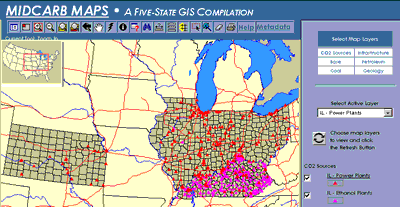| Kansas Geological Survey | Fall
2002 |
Vol.
8.3 |
|
Web-Based CO2 Data
CONTENTS CO2 Data–page 1 Ogallala Aquifer Institute–page 3
|
Carbon dioxide's possible role
in global climate change has challenged scientists to find ways to keep
this gas out of the atmosphere. Pumping carbon dioxide (CO2)
in deep underground rock formations, a process called CO2
sequestration, may be one way to safely dispose of CO2
over long periods of time. Five midwestern state geological surveys are combining efforts to develop
a digital database of information about CO2. This
cooperative project among Kansas, Ohio, Illinois, Kentucky, and Indiana
is called the Midcontinent Interactive Digital Carbon Atlas and Relational
DataBase (MIDCARB). MIDCARB is funded by the Department of Energy National
Energy Technology Laboratory. MIDCARB's main goal is to evaluate the potential for CO2
disposal in these five states. The database will identify large sources
of CO2 and potential sequestration sites. Sources
of CO2 emissions include power plants, steel mills,
refineries, and other fossil-fuel-burning industries. Potential sequestration
sites are producing and depleted oil and gas fields, uneconomic or unminable
coal seams, and deep saline aquifers. "Hydrocarbons continue to be the primary source of energy in the United States and the world," said Tim Carr, geologist at the Kansas Geological Survey and head of the project. "As long as we burn fossil fuels, carbon dioxide will be produced. Geologic reservoirs can provide safe and secure long-term sequestration sites."
The consortium is currently working on web-based interactive maps that
will be used to distribute information about the five-state region. When
the project is completed, it will provide a publicly available online
tool to evaluate the impact of CO2 sequestration
and serve as a model for projects in other areas. Digital access to pertinent
information will be critical in evaluating CO2
mitigation policies, directing research, and understanding the technical,
economic, social, and environmental challenges of CO2
sequestration. In addition to the potential environmental benefits of CO2
sequestration, pumping CO2 into reservoirs can
also enhance the recovery of oil from these underground rocks. Carbon
dioxide is pumped under high pressure into the reservoir through injection
wells, creating a CO2 flood bank. The front of
this flood bank mixes with the trapped oil, causing it to become more
mobile. As more oil is encountered, an oil bank forms in front of the
CO2 and is pushed toward producing wells where
it is pumped to the surface. Before an oil reservoir can become a candidate for CO2
flooding, however, it must be evaluated from a technical perspective and
an available CO2 source identified. Researchers
on the MIDCARB project are compiling a database of reservoir fluid and
rock properties that can be used to evaluate the feasibility of CO2
flooding of oil reservoirs. Data can be queried directly from the database
management systems, designed specifically to meet the criteria chosen
by the user. Users can build their own maps, and because data are being
added all the time, maps are based on the most current information. For additional information about the MIDCARB project, visit the MIDCARB web site at http://www.midcarb.org. |
|
Interactive map on theMIDCARB
website. |
 |
| Online February 10, 2003 Comments to: lbrosius@kgs.ku.edu Kansas Geological Survey URL:http://www.kgs.ku.edu/Publications/GeoRecord/2002/vol8.3/Page1.html |